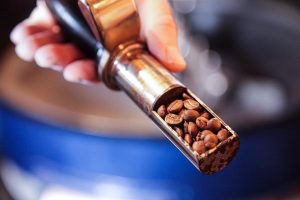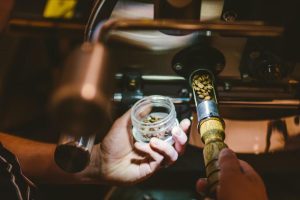What’s better than the smell of roasted coffee beans, a freshly brewed cup of coffee! That’s why many coffee lovers perk up when they think of the different roasts on the market.
Trying different types of coffee by sampling their rich aroma and amazing flavors is a great experience for any coffee enthusiast.
There are many exotic or unique coffees out there. Once you come across them in the grocery store, coffee shop, or roaster, you may wonder, what does this coffee taste like? A good example is micro roasted coffee.

Micro roasted coffee is a relatively new term in coffee-making circles. It refers to a process of roasting coffee beans that gets the most flavors out of them.
What is Micro Roasting?
Micro roasting refers to the process of roasting small batches of coffee beans (150 pounds or less) in a highly – controlled environment. That differs from the traditional coffee roasting process, which involves processing hundreds of pounds of coffee at a go.
Because the amount of beans roasted during micro roasting is so small, all the beans are evenly roasted. That ensures the flavor, aroma, and caffeine content is extracted from all of them to a roaster preference. The roasting process is also not rushed, ensuring the coffee beans are fully processed.
What Type of Beans are Processed Through Micro Roasting?
The beans processed through micro roasting can be single-origin beans or blends. What sets them apart is whether they are Robusta beans or Arabica beans.
Robusta beans are used to make commercial micro roasted coffee beans because they are less expensive to produce. They also have a stronger flavor and aroma than Arabica beans.
However, roasters prefer to use Arabica beans when processing micro-roasted coffee because of its interesting flavors. These beans have sugary and fruity notes reminiscent of blueberries.
Just like with regular roasts, micro-roasted coffee is categorized according to light, medium, and dark roasts.

Light roast micro roasted coffee beans have a fruity and floral flavor. They also contain more caffeine and less oils than dark roasts. You can expect a light and refreshing flavor from these coffee beans from start to finish. They are the perfect beans to use when brewing an afternoon cup of coffee.
Medium roast micro-roasted coffee beans are fragrant with subtle hints of chocolate and caramel. You can brew medium roast micro roasted coffee beans at any time of the day. They make a sweet and smooth cup of coffee with hints of chocolate and caramel.
Dark roasts have less caffeine and more oils because they are exposed to heat for longer during the roasting process. They are characterized by licorice, nutty, and caramel flavors.
Dark roast micro-roasted coffee is vibrant and full-bodied. It is best used to brew coffee in the morning. That’s the kind of boldly flavored, smoky, and sweet coffee with a strong aroma that you need when you wake up.
What Can You Expect From Micro-Roasted Coffee?
Micro roasted coffee is quality coffee. Because the quantity of coffee processed is small, roasters have time to choose the best coffee beans and process them carefully. That ensures all the beans undergo the right roasting process.
The time and focus it takes to produce micro-roasted coffee, sets it apart from other coffees roasted in large batches. Therefore, you’ll find micro-roasted coffee in specialty coffee shops and third-wave coffee shops that sell small, high-quality batches of coffee.
What Do You Need to Produce Micro-Roasted Coffee?
You may own a coffee shop and think you would like to try selling micro-roasted coffee in your shop. Or maybe you are a coffee lover who would like to roast your coffee from home.
It doesn’t take much to produce micro-roasted coffee. You only need a small batch of micro-roasted coffee and a roaster. Some examples of coffee roasters you can use at home are the Kaldi Home Coffee roaster, Korean Ceramic Handy Coffee Roaster, Behmor 2000AB Home Coffee Roaster, and Fresh Roast SR540.

You should keep an eye on the coffee beans you are roasting, ensuring they are consistently roasted. Once they are ready, package or store them in a way that preserves their aroma, acidity levels, body, and flavor.
Terms Used to Describe Micro Roasted coffee
Some terms used to describe micro-roasted coffee are buttery, which refers to coffee beans with a rich and oily flavor like in Sulawesi coffee. Others have an earthy or mushroomy flavor often associated with Indonesian coffees.
You will also find exotically flavored micro-roasted coffee similar to Kenyan AA coffee and those with floral characteristics such as Ethiopian coffee.
Other characteristics to look out for in micro-roasted coffee are smokey, nutty, and spicey.
How to Micro Roast Your Coffee From Home?
Now that you know a bit about micro-roasted coffee, you may decide to try it at home. We’ve given you a few examples of micro-roasters to use.
Go for an air roaster because they evenly roast coffee beans without scorching them.

Here are the steps to take during micro roasting.
- Select a great brand of green coffee beans such as Ethiopian Harrar, Sumatra coffee beans, Kenya AA coffee, Colombian coffee, or Sulawesi coffee.
You may choose a green coffee sample set that comes with different coffee beans to find the kind of flavor you prefer.
- Heat your roaster up to 327 degrees fahrenheit and put your green coffee beans inside. Monitor the smell of the coffee beans as they roast to identify which stage the green coffee beans are at.
During the first few minutes, the green coffee beans will turn yellow and emit an aroma like fresh-cut grass. The beans will also release some steam as their water content dissipates. That is referred to as the drying stage.
- Once the roaster hits 390 – 410 degrees fahrenheit, the beans will darken in color, hit the first crack, and audibly pop open.
At this stage, the sugar in the coffee beans will start to carmelize, and the aroma of the beans will get stronger as they release their oils.
If you prefer light roast coffees, stop your roasting process after the first crack when the temperature in your roaster is between 415 – 425 degrees Fahrenheit.
- You may continue to roast your coffee beans if you prefer a darker roast. Once the temperature hits 440 – 450 degrees fahrenheit, you’ll hear the second crack.
That is a sound that’s a bit louder than the pop you heard during the first crack. It signifies the second cracking of the coffee beans as they get darker and the sugars in them caramelize further. More coffee oils are also released from the coffee beans during the second crack.
Coffee beans roasted to the second crack have a more intense aroma than those roasted to the first crack. You can describe it as a smoky, spicy, and woody aroma.
The brew made from these coffee beans is lighter with less caffeine and a bitter-sweet taste that’s appealing to the palate. These beans can be referred to as medium to dark roast coffee beans.
- Roasting coffee beans beyond the 465 degrees fahrenheit mark burns off all their sugars and releases most of their remaining oils. As the coffee oils are burnt, they emit a strong charred aroma.
These beans are referred to as Dark roast coffee beans that; some people may refer to as French roast coffee. They have a slightly charred, nutty, chocolatey flavor and are best used to brew Espresso.
- By now, you’ve roasted your coffee beans to your satisfaction. If you are feeling adventurous, you may separate some coffee beans after each stage.
That will enable you to find out how each type of roast tastes after micro roasting. Then you can compare it to the batches of coffee you buy from the stores and see which is best.
At the end of the day, knowing how to micro roast coffee is one of the best experiences you can have as a coffee lover.
It will give you a better appreciation of different types of coffee beans and help you to choose the kind of coffee that suits you best.
Conclusion
Now you know something about micro – roasted coffee, you can create your own coffee blends and roast the coffee to your preferred level. It doesn’t require expensive equipment. If you can’t buy a commercial home coffee roaster, use a popcorn maker.
One thing is for sure, once you learn how to roast your own micro-roasted coffee, you will always have the freshest coffee at home that’s roasted to your preference.
If you feel roasting coffee is too complicated, try the various micro-roasted coffee brands on the market, such as Little Waves Coffee and Stone Street Coffee.
Related Articles